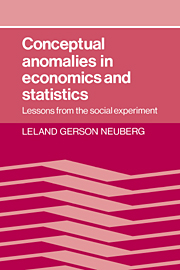Book contents
- Frontmatter
- Contents
- Preface
- Introduction
- PART I STATISTICAL LOGICS
- Chapter 1 J. S. Mill and some philosophical underpinnings of controlled experimentation
- Chapter 2 R. A. Fisher, randomization, and controlled experimentation
- Chapter 3 Some special difficulties of controlled social experiments
- Chapter 4 Hume's problem of induction in modern statistical inference and controlled experimentation
- Summary and conclusion of Part I
- PART II ECONOMIC LOGICS
- Conclusion: Some possible barriers to controlled social experiments as science
- Appendix: Proofs of theorems, lemmas, and propositions
- References
- Symbols and abbreviations
- Index
Summary and conclusion of Part I
Published online by Cambridge University Press: 16 February 2010
- Frontmatter
- Contents
- Preface
- Introduction
- PART I STATISTICAL LOGICS
- Chapter 1 J. S. Mill and some philosophical underpinnings of controlled experimentation
- Chapter 2 R. A. Fisher, randomization, and controlled experimentation
- Chapter 3 Some special difficulties of controlled social experiments
- Chapter 4 Hume's problem of induction in modern statistical inference and controlled experimentation
- Summary and conclusion of Part I
- PART II ECONOMIC LOGICS
- Conclusion: Some possible barriers to controlled social experiments as science
- Appendix: Proofs of theorems, lemmas, and propositions
- References
- Symbols and abbreviations
- Index
Summary
Chapter 1 took classical notions of causality and probability and fused them into a concept of gambling-device law (GDL). We also argued that the proposition that a GDL governs a given situation cannot, in principle, be based solely on what is observable. On the basis of the GDL concept, some assumptions based on the physical act of randomization, and some further assumptions not baseable on the observations, Chapter 2 constructed a theory of causal point estimation for statistical analysis of data from controlled experiments. We also argued that extensions of the theory to tests of hypotheses of no causal effects and no mean causal effect entail conceptual difficulties.
Chapter 3 argued that special features of social experiments may make Chapter 2's theory of randomization-based causal point estimation inapplicable to them. We also argued that the choice of a complex experimental design and any (unnecessary) failure to account for the complexity in subsequent statistical analysis could prevent Chapter 2's theory of causal inference from applying to a social experiment's results. Chapter 4 developed a second concept of probability (not baseable solely on observation) and constructed a theory of statistical inference (in which randomization has no role to play) based on the second probability concept and other assumptions not baseable on the observations. A social experiment's statistical analysis may be based on the second theory, but if so, randomization becomes a superfluous procedure, and the relationship between the experiment's results and propositions on cause and effect becomes unclear.
- Type
- Chapter
- Information
- Conceptual Anomalies in Economics and StatisticsLessons from the Social Experiment, pp. 114 - 116Publisher: Cambridge University PressPrint publication year: 1989



